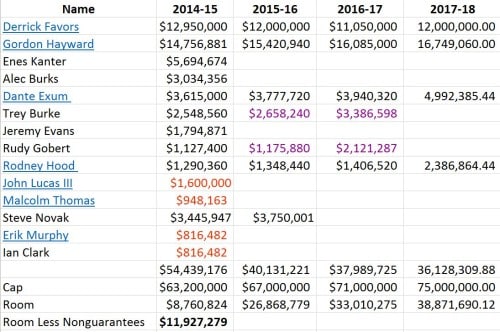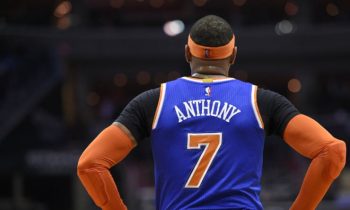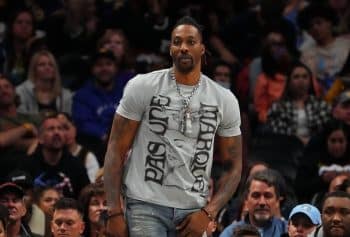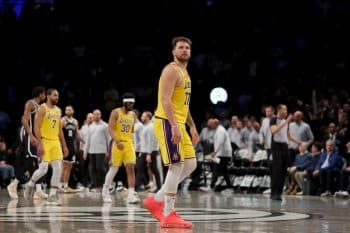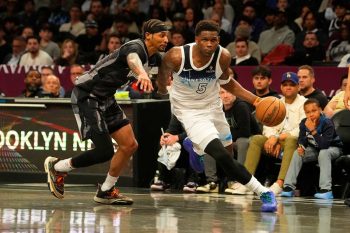FAD
Dunc’d On: The Utah Jazz’s Plan
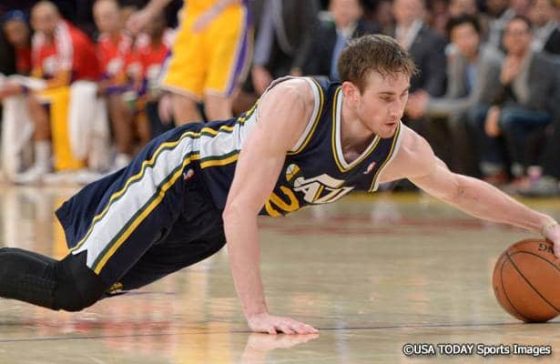
With news of a maximum offer sheet to Gordon Hayward from the Charlotte Hornets, it appears he bet right and the Utah Jazz wrong. Hayward asked for a reported four-year, $52 million contract last fall, a price the Jazz refused to meet. Ironically, it was the market rather than his own performance that really made this offer sheet for him. Hayward played pretty close to the lower end of what reasonably would have been expected from him last year barring injury. Yet as I wrote last week, he is still a better value at the max than most of the other free agents out there with the massive amount of available money around the league. That is why Hayward’s maximum offer sheet was all but inevitable. That, and the low opportunity cost, is also why the Jazz will match.
Here is how the Jazz’s salary situation would look after matching Hayward.
*Assumptions: Dante Exum and Rodney Hood sign for 120 percent of the Rookie Scale, as almost all rookies do. Hayward’s max is an estimate based on estimated $63.2 million cap figure. “Room Less Nonguarantees” figure includes 10 guaranteed contracts on the roster plus two $507,336 cap holds for empty roster spots if the nonguarantees are waived. Qualifying offers for potential restricted free agents are omitted.
With this offer sheet, Hayward is vastly overpaid for his production and upside, which looks more like quality starter than star. Paying the maximum for a player who very likely will never make an All-Star team is generally not a great way to run a franchise. But the Jazz are behind most teams in the success cycle right now. They are not ready to compete yet, and basically have no other expensive pieces on the roster aside from Derrick Favors. Plus Hayward has stayed very healthy through his career; the relative certainty attached to his production is worth paying a bit of a premium for.
Nevertheless, the high price means the Jazz might at least explore extracting an asset from Charlotte as a price for not matching. Because there is only a verbal agreement on the offer sheet at this point, the Hornets could still work out a sign-and-trade as essentially a bribe to prevent the Jazz from matching. But that must be done prior to the offer sheet being signed, as the CBA prohibits a team from providing consideration to deter a match once an offer sheet is officially executed (Article XI(5)(i, o).
Finding fair compensation would be difficult though. The Jazz could accept Michael Kidd-Gilchrist, Noah Vonleh or possibly even Cody Zeller as a bribe in a sign-and-trade. But the Hornets would be unlikely to give up those assets for the right to overpay Hayward, as he is a somewhat dubious value proposition even as is. Nonetheless, it would be worth at least discussing.
Assuming such talks were not fruitful, the Jazz should match. There is little opportunity cost to doing so. Hayward, while overpaid in a vacuum, is still one of the more efficient uses of cap space this summer. Utah would still maintain up to $11.9 million in cap room this summer and up to $21 million next summer* even after picking up a second rounder from Toronto as the price for taking on Steve Novak. That is plenty of room to take on salary dumps for draft picks again should they so choose, as they did last summer in the trade with Golden State that facilitated the Andre Iguodala signing. They’ve been rumored to be a suitor for Jeremy Lin, in order to land a draft pick or young asset from the Houston Rockets as they desperately try to move his expiring deal.
*Accounting for cap holds and an estimate for next year’s first rounder, which should be relatively high again.
Assuming they match, a strategy for the Jazz over the next few years should take shape. First, continue to develop players this year under Quin Snyder, specifically Dante Exum. Try to figure out what position they want to play Exum at, and whether he and Trey Burke can play together. Second, try to sign Alec Burks and Enes Kanter to discounts this year, as they will be restricted next year. That would eat into next year’s cap space, but if they can sign the two for about $12 million combined, they should do so. With the amount of cap space available around the league on a now-yearly basis, such players signed at an extension discount accounting for the benefit of getting security a year early are easily moved if necessary. Teams with cap space would likely rather trade for those contracts (and possibly throw in an asset for the privilege depending on the player) than be forced to sign players to the open market premium. Third, add another high draft pick next year.
With Burks and Kanter hopefully extended and another draftee in tow, the Jazz can continue forward with this squad and try to figure out who the keepers are. With the remaining cap space in the summer of 2015, they could sign a veteran who can play some defense (which will be a major problem with this roster next year) and try to make a major leap forward in 2015-16 as players like Hayward, Favors, Burks and Kanter enter their primes. The hope would be, as Dennis Lindsey has said, that someone in the current non-Exum group will exceed expectations. With so many young players to bet on, that could well happen for at least one of them.
Hayward’s contract is for only three years with a player option for a fourth, so if this group does not work out, he will expire along with Favors no later than the summer of 2018. If all goes according to plan, Exum (a player I am very high on) will be a star worthy of his own max contract by then, and the expirings will provide flexibility to reload around him if the current crop doesn’t work out.
